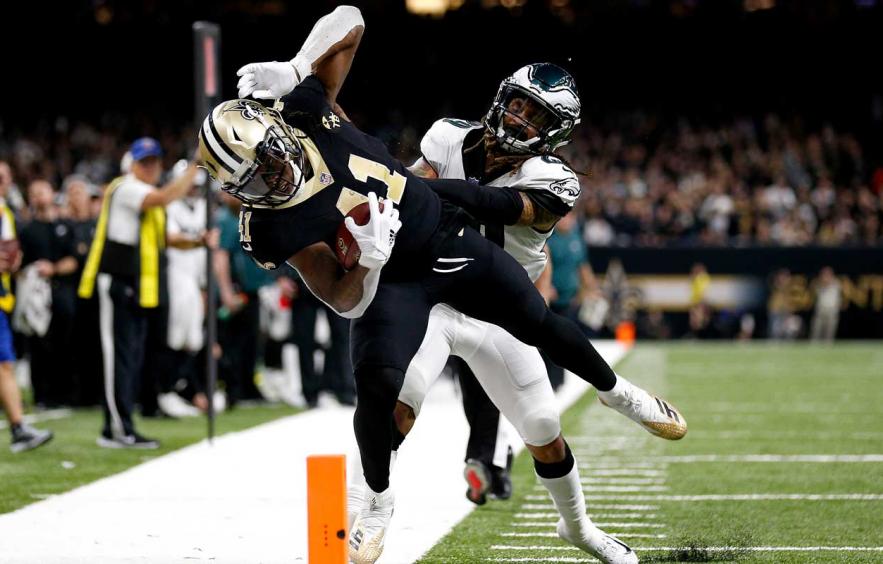The Ultimate Guide to Waiver Wire & FAAB Strategy

Fantasy football players wait all offseason to draft their season-long team(s). But that's only the beginning.
Once the season begins, it becomes vital to master the waiver wire. We’ve all been there before: you drafted the perfect team and nothing can stop it now. Not your league mates, your default draft score. Nothing.
Then, injuries begin plaguing your roster. That offense that was bound to score 30-plus points every week fails to post 30 during the first month of the year. And yet again, you find yourself stuck hoping those players that were promised actually break out rather than failing to perform to expectations.
Mastering your draft is just the tip of the iceberg. If you choose to ignore the rest of your role as a fantasy manager, bad things will come.
There are numerous ways to navigate waivers. The following is an in-depth look at different formats, strategies, and other considerations for your season-long league(s). To win your league, it is paramount to understand your league format and ways to have it benefit your team. League winners win at every step.
Waiver Formats
Every league is different and calls for a different approach to waivers. The following are not a be-all-end-all, especially with leagues agreeing to alter most formats to whatever works best for that group of friends.
Waiver Priority
The waiver priority is officially set following Week 1. The team at the top gets the first pick, followed by the second team, and so on. The team that gets priority can be set in a number of ways:
- Worst is first - The team with the first record gets the first choice, and the win-loss record decides this every week.
- Rotating - The choice to make a pick goes one through however many teams, and if you make a selection, you go to the end of the priority queue. The top team would have the last waiver priority the following week, and it cycles each week.
- Continuous - Once you make a claim, you move to the bottom of the list. This applies to every team. Example: Team 6 does not make a waiver claim and eventually moves to the top of the queue. Team 6 would stay at one each week until the owner uses their claim.
These priority waiver options tend to be the most popular.
First Come, First Served
The name says it all. Usually the first is served at a set time and runs until waivers close. OR, waivers do not close and run the entire season that way. This is a difficult option if your league mates do not live in the same time zones, let alone incorporate family life, other past times, or non-traditional work schedules.
FAAB
FAAB is short for Free Agent Acquisition Budget, or Free Agent Auction Bidding, and is most often used in high-stakes leagues to create an even playing field.
Managers have a set amount of FAAB—$100 or $1000 of fake cash is standard—to spend on waiver claims for the season. Waivers then open for a 24-hour period to everyone, with players being awarded to the manager who blindly wagered the most. FAAB has seen an increase in popularity over the last five years since it runs at the same day and time for everyone.
Strategies
Waiver Priority
Your waiver priority usually depends on your priorities (no pun intended). If you sit atop your league as the next manager to make a claim, it may make sense to sit and wait for a significant injury, QB change, etc. The only time this strategy would not work is if you stream a onesie position (see below).
Other ways to utilize this style is through trades, blocking other teams from a player/position of need, and building your roster with an eye towards the playoffs.
First Come, First Served
In my experience, this method gives an edge to those in your league with favorable work schedules or a bachelor/bachelorette lifestyle. All it takes is one busy day and suddenly that league-winning player you knew you had to pick up is on another roster. First Come, First Served rewards those who keep their head on a swivel all day, every day.
FAAB
Former 4for4er and friend in life Pat Fitzmaurice of FantasyPros researched FAAB recommendations from four years' worth of waiver wire articles and presented the average percentage recommended for each position. I updated those numbers using the 2021-2022 seasons.
John Daigle covers the waiver wire using dollars and FAAB percentages, with odd numbers as the default amounts since most players use arbitrary even numbers ($10, $20, $30) as their max bids. Here are his recommendations:
QB: 1% FAAB budget spent and rarely up to $10
RB: 8.1%, up to $26
WR: 9.1%, up to $12
TE: 5.7%, up to $11
The goal of onesie positions such as QB and TE is to use as little draft or FAAB capital as possible to find the best option as the season goes on, or streaming. That has been a strategy popularized over the past 10 years as tight end and defensive scoring has been understood to be matchup-dependent (and the most volatile).
Running backs and wide receivers will have a lot more weekly recommendations and options on the waiver wire. Spending more at RB and WR occurs often because your starting lineup requires multiples of each (in the majority of leagues) and are often the players scoring the most points in fantasy football. Running back contingency options are also prioritized for clever managers to stay ahead of injuries.
The other concern with using FAAB is deciding which players to use your budget on. Sometimes your draft falls short, or players do not meet expectations early. It seems smart to bid large early. But remember: health, playing time, schedules, and schemes are analyzed on a case-by-case basis. Just because Player X looks like the new workhorse in a backfield does not mean he stays that way or gets that opportunity (thanks, Kyle Shanahan).
There are occasional players to go all-in on, the most recent examples being Justin Jefferson during his rookie year or Christian Watson beyond Week 10. Keeping up to date on depth charts and opportunity remains crucial (and is a key part of Daigle's weekly process in the Waiver Wire).
Considerations for Waiver Claims
Strength of Schedule
SOS can be a fallacy but in some instances it carries weight. A running back could become the top option for the worst team in the league, but a favorable schedule that includes three straight games against the top teams in the league is not always worth a waiver claim.
Another way to use the schedule is to fill a starting spot during a bye week. Sometimes the top option is not the best because of the matchup. The fifth or sixth-best wideout on waivers may end up having the best matchup for one week because of their opponent. Therefore, that is the player you want to add. The 4for4 Look Ahead Planner is the perfect tool for this.
Aim High
Similar to any spike-week option based on usage and matchup, targeting players with a high ceiling for the remainder of the season is something to do before said player receives an opportunity to shine. This can happen for a multitude of reasons including losing teams developing their depth once the playoffs are out of reach. That third-round rookie runner or late-round receiver have flashed and may finally get well-earned work to close the year.
Adding those types of players as your depth in Weeks 8-12—Zay Jones comes to mind—can be the difference between a first-round playoff exit and a Fantasy Championship.
Follow the Books
Vegas insiders have a better projection of NFL teams and ensuing performances than we do. Adding players from games with high expected point totals is just another way to be ahead of your league mates.
Streaming
As discussed earlier, streaming is an optimal method to mix and match players until they’re too good to replace. Quarterback and tight end are the easiest matchup-dependent skill positions to do this with since (typically) only one at each spot is required.
Kickers and Defense
Do not draft these positions until the last two rounds and do not look to burn higher claims on them. Even if a team defense turns out to be the best option all season, the points they offer are not worth more than the contingency running back or wide receiver you could have drafted instead. Treat these positions as low-cost options.
Sabotage
Not every big-named player has a good season. Teams that are good may tend to sabotage-drop a well-known player to add at a position of need. Another team will see the big-name player, add them, and potentially drop a useful player themselves. If that dropped player would look good on your roster, you know what to do.






















